|
Handheld Nautiz X5
High-performance, top-of-the-line rugged handheld computer with integrated scanner, full VGA graphics, and 3G voice/data communication
(by Conrad H. Blickenstorfer; photography by Carol Cotton -- view PDF version)
The Handheld Group, located in Sweden and founded in 1997, is a worldwide suppliers of ruggedized handhelds for use in markets such as utility, military, logistics, forestry, transportation and field service. Handheld has a full lineup of rugged tablet computers and rugged industrial PDAs, such as the Nautiz X5 that is the subject of this review.
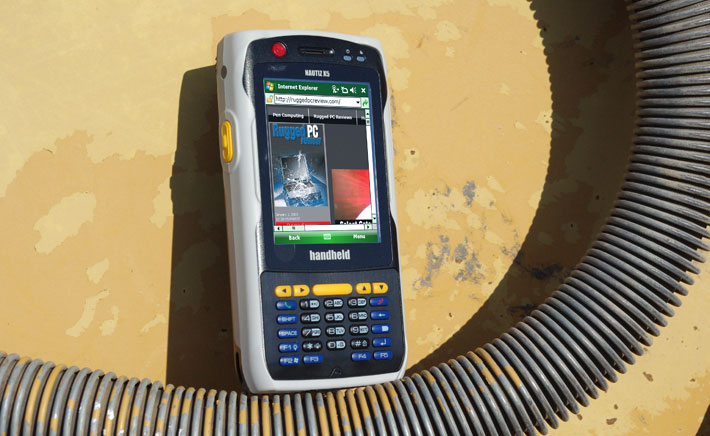
A ruggedized Pocket PC/scanner/phone/GPS system
In Handheld's growing, cherry-picked lineup of some of the best handheld computers in the world, the Nautiz X5 represents the mobile computing equivalent of the Porsche Cayenne Turbo S side of things. This is a supercharged multi-function rugged handheld computer for those who need superior performance and high end features in a tough package that's only a bit south of the company's Nomad and Recon models in terms of sealing and ruggedness. And a key selling point here is the inclusion of 3G cellular for voice and high-speed data communication.
The Nautiz X5 is built on Marvell's next generation PXA320 processor, a chip that runs at 806MHz, faster than any of the older XScale chips that have powered, and still power, several generations of Pocket PCs, PDAs and other handhelds. The PXA320 can scale from its blistering top speed of 806MHz (the control panel calls this "turbo mode") to 624MHz and less to conserve power when full performance isn't needed. The processor is in fact more energy-efficient than the predecessor PXA270 "Bulverde" chip, especially under heavy video and audio load.
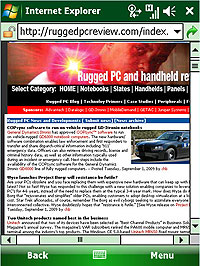 The analog resistance touch panel display uses a large 3.5-inch transflective LCD with full 480 x 640 pixel VGA resolution as opposed to the lesser 240 x 320 QVGA format used by most handhelds. The display is bright and ultra-crisp, and can display even the tiniest details and smallest fonts (click on the screen picture to the right to bring up a full-scale screen capture and see just how much information you get on a PDA display). The screen is a pleasure to use indoors and remains acceptably viewable outdoors. The LCD also offers a wide viewing angle both horizontally and vertically with only minor color shifts when viewed from horizontal angles. That is not as big a deal as with notebooks. Screen brightness can be adjusted in 16 steps from full bright down to fairly dim, and you can also turn the backlight off via key. The analog resistance touch panel display uses a large 3.5-inch transflective LCD with full 480 x 640 pixel VGA resolution as opposed to the lesser 240 x 320 QVGA format used by most handhelds. The display is bright and ultra-crisp, and can display even the tiniest details and smallest fonts (click on the screen picture to the right to bring up a full-scale screen capture and see just how much information you get on a PDA display). The screen is a pleasure to use indoors and remains acceptably viewable outdoors. The LCD also offers a wide viewing angle both horizontally and vertically with only minor color shifts when viewed from horizontal angles. That is not as big a deal as with notebooks. Screen brightness can be adjusted in 16 steps from full bright down to fairly dim, and you can also turn the backlight off via key.
For storage, the Nautiz X5 comes with 256MB of SDRAM and 512MB of Flash memory, both generous amounts for a Windows Mobile device. A microSD card slot can be used for up to 2GB of additional storage. A powerful 16.3 watt-hour rechargeable battery pack provides all-day operation under normal use.
The Nautiz X5 has a built-in 3-megapixel camera that can also shoot video in QVGA format, and it has an LED illuminator to provide extra light.
As a data capture device as well as a communicator, the Nautiz X5 has both a touch screen and a small keypad to speed up data entry. What you get in the standard version is a full phone-style numeric/alpha keypad, navigation keys, five function keys, phone pick up and hang-up buttons, and two soft buttons.
For scanning, there is an integrated 1D and PDF417 Class II laser barcode scanner. Optionally available is a 1D/2D imager.
The whole package runs Windows Mobile 6.1, the latest version of Microsoft's Pocket PC operating platform that now also includes phone functionality. The device is 6.3 inches long, 3.1 inches wide, and about 1.4 inches thick. Our tester weighed 14.8 ounces with battery and wriststrap installed.
Overall, the Nautiz X5 is a powerful Windows Mobile computer with integrated laser scanning, WiFi and 3G voice/data capabilities, and a superb hi-res display. It is powerful enough to run complex applications, and tough and rugged enough to be suitable for just about any outdoor job where performance, flexibility and an all-day battery matter. Oh, and in case you wonder where the name Nautiz comes from, it stems from one of the early runic alphabets where it translates into something like the need or desire and hardship to achieve.
A look at the Nautiz X5 hardware
The Nautiz X5 can be described as a high-end industrial PDA, positioned between a standard Pocket PC and an industrial handheld. It has a spacious 3.5-inch LCD with full 640 x 480 pixel resolution. That means a very high resolution of almost 230 dots per inch, leaving even the vaunted iPhone's 160 dpi in the dust. As a rugged device, the Nautiz X5 is considerably larger and heavier than consumer Pocket PCs, but smaller and handier than most industrial terminals. It's made of tough ABS plastic and feels very solid and very well built.
 The image below to the right shows the unit from the front and from all four sides. Going around the Nautiz X5: The image below to the right shows the unit from the front and from all four sides. Going around the Nautiz X5:
- The top of the unit features the barcode scanner window.
- On the left side is a yellow laser scan button and on top you can see the tip of the stylus in its garage.
- On the right side is a second yellow scanner activation button, a sealed headphone port, and an IR port.
- The backside of the Nautiz X5 houses the battery with the SAM and SIM card slots underneath it as well as the camera and the LED flash. There is also a hand strap, the reset button, and a sealed speaker.
- The front side has, in addition to the screen and keypad, the microphone, speaker, and two indicator lights for charge status and wireless radio status.
- On the bottom are the surface-mount cradle contacts as well as a charge and USB/serial/Ethernet port connector that can be sealed with an attached and hinged rubber plug.
Not visible is the unit's microSD slot that is located inside the device, underneath the battery. This way it's nicely protected and still readily accessible. Note that it's only a microSD and not a microSDHC, so maximum capacity is 2GB.
The design of the housing is clean and functional, with great attention to detail. Manufacturing and finish are of very high standard. The unit feels like it is built to last.
A peek inside
Since we usually cannot resist taking a peek inside the rugged systems we review, below is a look at the guts of the Nautiz X5. The interior layout, fit, and finish tells a lot about the thought that went into the design of a product, and also how well it is made.
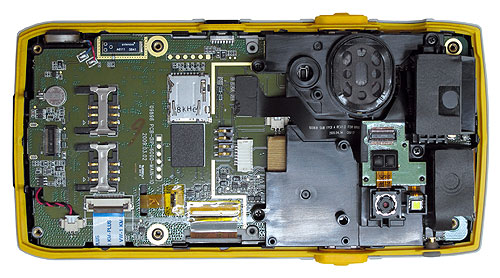 The housing consists of two ABS plastic halves that are sealed with an intricately designed and detailed yellow silicon seal that runs around the entire perimeter and also includes injection molded scan buttons. This way, the scan buttons do not have to be sealed individually. This is sort of a combination of O-ring, pressure seal and side bezel all rolled into one. The combination of light gray and black plastic with the bright yellow seal makes for an attractive combination, though you cannot actually see the seal when the unit is assembled. The housing is very sturdy and looks to be of high quality inside and out, with excellent fit and finish.
The housing consists of two ABS plastic halves that are sealed with an intricately designed and detailed yellow silicon seal that runs around the entire perimeter and also includes injection molded scan buttons. This way, the scan buttons do not have to be sealed individually. This is sort of a combination of O-ring, pressure seal and side bezel all rolled into one. The combination of light gray and black plastic with the bright yellow seal makes for an attractive combination, though you cannot actually see the seal when the unit is assembled. The housing is very sturdy and looks to be of high quality inside and out, with excellent fit and finish.
On the left side you can see the dual SIM/SAM card slots, towards the middle the microSD card slot. On the right side are the large speaker, the fairly elaborate autofocus camera assembly, and the laser scanner. The housing is held together by eight small Philips screws.
Windows Mobile 6.1
The Handheld Nautiz X5 comes with Windows Mobile 6.1 that includes a variety of standard applications and utilities. Among them are mobile versions of Word, Excel, PowerPoint and OneNote. It also includes PIM applications, mail, web browsing, Windows Messenger, a picture viewer and a good number of control panels.
Why did Handheld pick Windows Mobile 6.1 instead of Windows CE 5.0 or 6.0 with their more industry-oriented look and feel and functionality? It's a judgment call. These days, Microsoft differentiates between Windows Embedded CE and Windows Mobile. Windows Embedded CE is a scalable 32-bit OS designed for intelligent devices ranging from enterprise tools such as industrial controllers, communications hubs, and point-of-sale terminals to consumer products such as cameras, phones, and home entertainment devices. 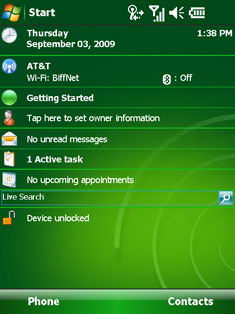 Microsoft uses the term "Embedded CE" for both early versions of Windows CE (2.1 and 3.0) as well as versions released after consumer devices split from more industrial devices, such as CE .NET and then Windows CE 5.0 and 6.0. Microsoft uses the term "Embedded CE" for both early versions of Windows CE (2.1 and 3.0) as well as versions released after consumer devices split from more industrial devices, such as CE .NET and then Windows CE 5.0 and 6.0.
Windows Mobile, on the other hand, is a platform that is also based on Windows Embedded CE, but has the more consumer-oriented look and feel and features required for PDAs and smartphones. A device like the Nautiz X5 could be used either with Windows CE or Windows Mobile, depending on the intended application. In general, customers who design their own custom applications may lean towards a Windows CE implementation whereas customers with more general needs prefer the friendlier Windows Mobile platform, and that is what Handheld offers in the speedy Nautiz X5.
While Microsoft's smallest OS has always lived in the shadow of "full" Windows, CE is a multi-threaded, multi-tasking, fully preemptive OS environment that had been targeted from the start specifically for low-power, economical hardware with limited resources. However, Windows CE supports a rich subset of Microsoft Win32 APIs and many additional programming interfaces.
The bigger picture is that Windows Mobile remains a curious animal. Unloved by most (and it seems even Microsoft), the platform nevertheless became the de-facto standard for industrial and vertical market handhelds, and that seems unlikely to change anytime soon. The look and feel of Windows Mobile really hasn't changed much in a good decade, so while it may have industrial-strength underpinnings, it feels dated compared to the Apple iPhone or the Palm Pre.
Controls and data input methods
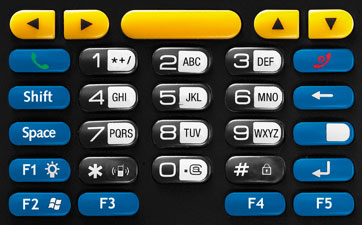 As far as data entry and navigation go, you can interact with the HHCS Nautiz X5 either via touch screen or via a keyboard/keypad or both. Hardware controls include up/down, left/right and enter keys in a somewhat unusual horizontal block of orange keys. Below that is the centrally located phone-style numeric/alpha pad that can also be used for phone-style text entry. One feature that's been overlooked here is the totally terrific Tegic T9 predictive text entry. Millions of texting addicts are using it, and they are far more adept at T9 than any other text entry method. The Nautiz should definitely have T9. As far as data entry and navigation go, you can interact with the HHCS Nautiz X5 either via touch screen or via a keyboard/keypad or both. Hardware controls include up/down, left/right and enter keys in a somewhat unusual horizontal block of orange keys. Below that is the centrally located phone-style numeric/alpha pad that can also be used for phone-style text entry. One feature that's been overlooked here is the totally terrific Tegic T9 predictive text entry. Millions of texting addicts are using it, and they are far more adept at T9 than any other text entry method. The Nautiz should definitely have T9.
To the left of the keypad is the phone answer key, shift and space keys. To the right are the phone hangup, backspace, return and function keys. Below, there are five function keys assignable function keys.
Above the display are two indicator lights. The one to the right glows amber when wireless is on and blinks blue for activity.
For audio, there is a microphone below the keypad, a small speaker for phone operation above the display, a generously-sized speaker in the back, and a headphone connector on the right.
For operation via stylus, the Nautiz X5 comes with a 4-inch fixed metal stylus with nylon tip. When not in use, it fits into a slot on the upper right. You can also use touch to operate the Nautiz X5, but Microsoft clearly designed the Windows Mobile interface for use with a stylus.
For data entry, Windows Mobile offers a wealth of options. There is the integrated keypad. There is a nice pop-up keyboard and three are also no fewer than three different ways of recognizing text. They are:
- Block Recognizer, which uses the special Graffiti alphabet Palm invented in the 1990s. The idea here is that almost all letters are "unistrokes," or consisting of a single uninterrupted stroke, which makes them easy to recognize for the computer. The slightly abstracted alphabet is quite easy to learn. Millions used it on Palm Pilots.
- Letter Recognizer, which also recognizes individual letters instead of whole words, but uses the standard alphabet instead of the slightly modified one of the Block Recognizer. And whereas the Block Recognizer lets you shift case, the Letter Recognizer, which goes back to a product called "Jot" by (CIC) Communication Intelligence Corporation, has different data entry boxes for upper case, lower case and numerals.
- Transcriber, which is a full-function handwriting recognition system that also goes way back almost to the beginning of PDAs more than 15 years ago. Microsoft bought the rights to it a number of years ago and it's been part of Windows Mobile ever since.
Any of those input methods, once mastered, work very well. Below you can see screenshots of the onscreen keyboard, the Block Recognizer, and Transcriber.
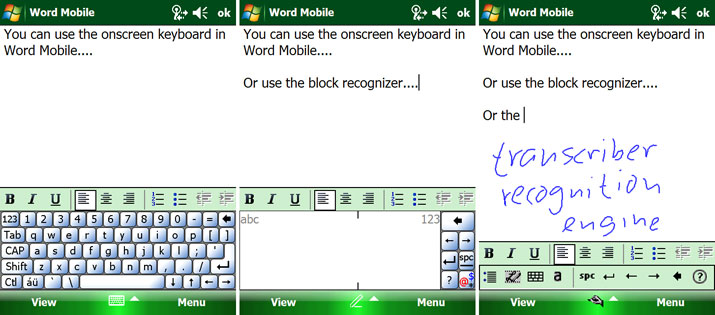
To provide even greater input flexibility, Handheld also offers a version of the X5 that has a full QWERTY thumb-type keyboard.
Using the Nautiz X5 as a phone
As long as you have a SIM card and an activated account for it, the Nautiz X5 can be used as a full-function smartphone. Windows CE has had very competent phone extensions going back as far as 2002 when Microsoft introduced the Pocket PC Phone Edition.
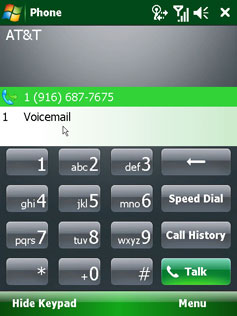 By now Microsoft has seven more years of Pocket PC phone experience, and the Nautiz X5 takes full advantage of that. For our testing I used the SIM from my AT&T LG Shine and it worked without as much as additional configuration. The X5's voice quality is excellent, and actually better than that of most of today's tiny dedicated phones. And since this is what used to be called the Pocket PC Phone Edition, you're not just adding cell phone capability to a rugged PDA; the wireless capabilities are integrated deeply into the device. By now Microsoft has seven more years of Pocket PC phone experience, and the Nautiz X5 takes full advantage of that. For our testing I used the SIM from my AT&T LG Shine and it worked without as much as additional configuration. The X5's voice quality is excellent, and actually better than that of most of today's tiny dedicated phones. And since this is what used to be called the Pocket PC Phone Edition, you're not just adding cell phone capability to a rugged PDA; the wireless capabilities are integrated deeply into the device.
To bring up the phone, simply push the phone button or select "Phone" from the menu. The phone application shows the last call, an onscreen keypad, and access to call logs and speed dial. The call log provides summary information about the number of calls and call time. Individual call log entries provide one-button call-back or SMS messaging as well as access to any notes that may be attached to a call. Or you can create a new Contacts entry automatically. You can also take notes during a call. The note will have the caller's name, the phone number, and the time of the call already on it. Needless to say, to take a note you'll have to use the Nautiz X5 with headphones and with the speakerphone on. Volume for the phone can be set separately from the system itself. There is also a vibrate function.
All of this means that the Nautiz X5 can be used as a full-function phone in addition to everything else it does. There are a couple of criticisms. First, I felt the button arrangement isn't optimal for phone use. The green and red phone buttons are tiny and sort of disappear beneath the bright yellow up/down and left/right buttons. Second, while you can put people on hold and toggle between calls, I did not see a conferencing function.
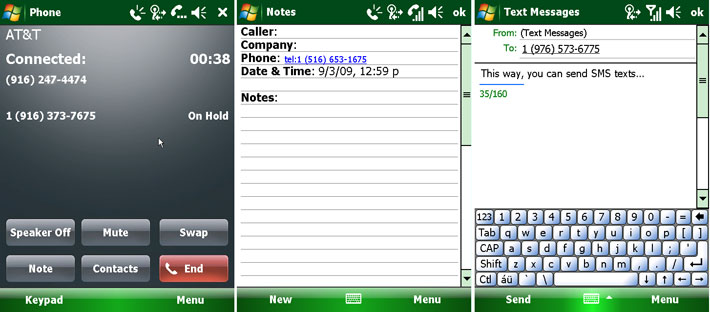
Communication and connectivity
 Like most mobile devices today, the Nautiz X5 can connect in a variety of ways. Wired connectivity is all via dock. The X5 has a set of gold-plated surface-mount contacts to communicate with its cradle, and the cradle supports USB host, USB client and serial via one cable, and RJ45 Ethernet via another. Like most mobile devices today, the Nautiz X5 can connect in a variety of ways. Wired connectivity is all via dock. The X5 has a set of gold-plated surface-mount contacts to communicate with its cradle, and the cradle supports USB host, USB client and serial via one cable, and RJ45 Ethernet via another.
The Nautiz X5 comes standard with integrated 802.11b/g WiFi as well as Bluetooth 2.0 + EDR. Voice and data functionality is provided by an integrated Siemens HC25 HSDPA module. The Wireless Module HC25 offers tri-band UMTS/HSDPA, quad-band GSM/GPRS/EDGE communications, and was specifically designed for mobile and industrial applications. It supports 850/900/1800/1900MHz GSM and EDGE technology, and operates in all existing GSM networks in the United States, Europe and Asia. Tri-Band UMTS/HSDPA operation is on 850/1900/2100 MHz.
When within range of a network, 802.11b/g wireless can be used for web browsing, email, terminal emulation sessions, synchronization or, thanks to the unit's microphone and speaker, for VoIP (Voice over IP) voice communication. For optimal WiFi performance there is an Antenova Comata 2.4GHz SMD antenna module, an elegant, space-saving high-performance solution with excellent antenna patterns.
While infrared communication is no longer as popular as it once was, the Nautiz X5 has an IrDA port on its right side. This still comes in handy for peripheral connectivity and even synchronizing.
Connection to a PC for synchronizing or communication with a backend server or peripheral can be via USB, WiFi, WWAN, or Bluetooth. Relationships can be established via standard Microsoft ActiveSync.
The screen image on the right shows the Windows Mobile Wireless Manager. It allows one touch activation and deactivation of WiFi, Bluetooth and phone. It also provides access to the settings screens for all three wireless radios.
The Nautiz X5 also includes an integrated state-of-the-art GPS SIRF Instant Fix II technology. Our review unit did not include GPS or mapping software, and so we cannot comment on GPS performance.
SAM — Security Authentication Module
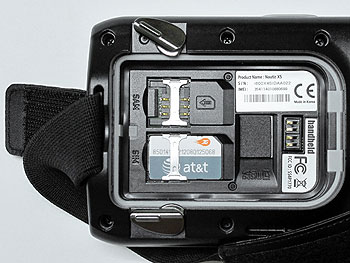 When you open the battery compartment cover of the Nautiz and take the battery out you see two SIM card slots, though the specifications only mention one. I first thought this was so you could use two SIMs and two phone numbers in the same device. When you open the battery compartment cover of the Nautiz and take the battery out you see two SIM card slots, though the specifications only mention one. I first thought this was so you could use two SIMs and two phone numbers in the same device.
Turns out, one of them is actually a SAM card slot and not a SIM card slot. SAM stands for Security Authentication Module. The SAM standard describes a smaller size smart card that is often used to store cryptographic keys in point-of-sale terminals, and is also used for medical applications, government projects or anywhere else where access security matters. Check here or here for a description of Security Authentication Module technology.
When I asked Handheld about the intended use of the SAM slot, they said that "SAMs are used as a security feature in handling transactions or dealing with valuable information. At the moment the most widespread use is in Public Transportation where SAMs most often are a requirement and are used for verifying payments and or additions/subtractions of value from Smart cards."
3-megapixel camera
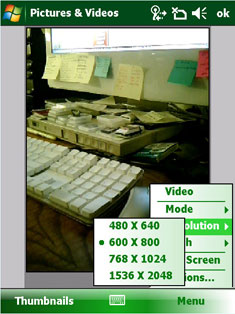 Like almost all modern handhelds and smartphones, the Nautiz X5 has an integrated camera. Thanks to advanced CMOS imager technology, it is now possible to have high resolution still and video camera functionality even in very small devices. In terms of speed and image quality, these camera modules are not meant to replace a standard photographic camera by any means; they are simply meant to provide additional functionality. Like almost all modern handhelds and smartphones, the Nautiz X5 has an integrated camera. Thanks to advanced CMOS imager technology, it is now possible to have high resolution still and video camera functionality even in very small devices. In terms of speed and image quality, these camera modules are not meant to replace a standard photographic camera by any means; they are simply meant to provide additional functionality.
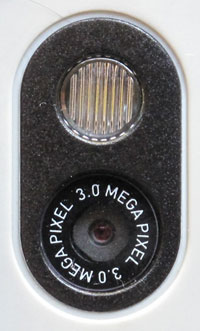 The Nautiz X5's integrated camera can snap images with resolutions of up to three megapixel. It also has an LED illuminator that you can turn on and off via software to add extra light. It's not a flash, but can help generating better close-up pictures. The Nautiz X5's integrated camera can snap images with resolutions of up to three megapixel. It also has an LED illuminator that you can turn on and off via software to add extra light. It's not a flash, but can help generating better close-up pictures.
The camera can take pictures with resolutions ranging from 480 x 640 pixels all the way up to full 1536 x 2048 pixels. Default operation is via the Pictures & Videos application that offers a good variety of image capture and playback options. You can play slide shows, designate a picture as the Today wallpaper, beam a shot via IR, email in various sizes, and so on. In capture mode you can set a self-timer or do 5-shot burst mode (not very fast but maybe still useful), you can set white balance as well as brightness. In video mode you can record at 320 x 240 pixels and set limits (15 seconds or 30 seconds).
All of this is operated by the Windows software that even with the X5's speedy processor is slow and cumbersome, with the usual Windows Mobile combination of menus, pulldowns and check boxes. Picture quality is reasonable albeit nowhere close to a dedicated camera. The frame rate of video is low. The camera function of the Nautiz X5 is clearly meant to increase the unit's usefulness by letting you document things when you don't have a camera with you, but it does not replace a camera.
Note that Microsoft's sluggish Camera application is often replaced by third party applications that work much better, or developers and systems integrators include camera and video functionality directly into custom applications.
Power
The Nautiz X5 is powered by a rechargeable 4,400mAh 3,7 Volt Lithium-Ion battery. This amounts to a very generous 16.3 watt-hours--much more than most handhelds. We measured the device as drawing less than two watts, depending on backlight level and whether or not the wireless radios were on. Handheld claims "all day operation." Based on the power draw, that is definitely possible.
The battery is part of the backside of the unit and fits flush into the device. Two friction sliders secure the battery. They may accidentally both open, but it is not likely.
Ruggedness
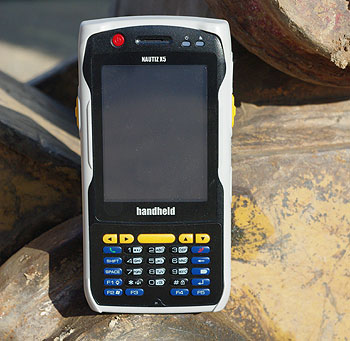 While the Nautiz X5 is not an ultra-rugged device, its light weight, impact-resistant plastic housing and overall design and construction make it able to handle the use and abuse that may be encountered in industrial applications. While the Nautiz X5 is not an ultra-rugged device, its light weight, impact-resistant plastic housing and overall design and construction make it able to handle the use and abuse that may be encountered in industrial applications.
Handheld rates the unit as capable of handling multiple 6-foot drops onto steel. The unit has a very wide operating temperature range from -4 to 131 degrees Fahrenheit. This makes the Nautiz platform able to handle operation in freezers as well as desert-like conditions.
Sealing — the ability to keep out dust and water — is crucial for a handheld computer. The Nautiz X5 carries an IP65 ingress protection rating. The "6" means the unit's inside is totally sealed against dust. The "5" means it can handle low-pressure water jets from all directions. It's not completely waterproof like the Nomad mobile computer that Handheld also sells, but close enough.
Scanning and RFID
The Nautiz X5 comes with an integrated Class II 1D laser capable of reading a variety of codes and symbologies. The unit can also be ordered with a 1D/2D CMOS imager. A special Barcode Setting control panel lets you set output destination, preamble, subamble in the virtual wedge section. You can also configure settings for all supported symbologies, and there is a panel to configure fix, volume and mode.
If RFID is required, Handheld offers a separate version of the Nautiz called the Nautiz eTicket. The eTicket is specially configured for payment transactions and validations. The built-in smart card reader supports various ISO14443 type A/B RFID devices, including the entire MIFARE family, a technology used for most contactless smart card projects and a favorite within the automatic fare collection industry (see info on MIFARE). The contactless electronic link between the card and the reader allows for the quick interface required for security and payment systems.
Summary
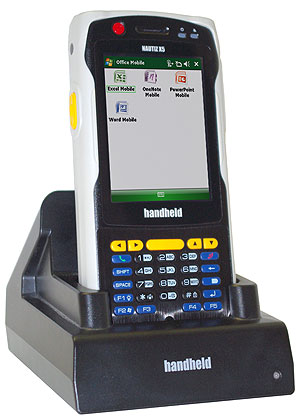 The Nautiz X5, offered by Handheld U.S., is a high-end compact and handy multi-purpose PDA that's barely larger than a consumer Pocket PC, yet can handle a lot more abuse.
The Nautiz X5, offered by Handheld U.S., is a high-end compact and handy multi-purpose PDA that's barely larger than a consumer Pocket PC, yet can handle a lot more abuse.
It is built around Microsoft Windows Mobile 6.1 and the 806MHz Marvell PXA320 processor (the fastest currently available processor for mobile devices), has a brilliant full-VGA 3.5-inch touch display, and can function both as a PDA as well as a full-function quad-band GSM/GPRS/EDGE smartphone and a tri-band UMTS/HSDPA data communicator (all you have to do is insert an activated SIM). Yet, despite its small size and polished looks, the Nautiz X5 is a tough industrial PDA that can handle extreme temperatures as well as multiple 6-foot drops. IP65 sealing means the unit is totally dustproof and is impervious to even jets of water from all sides.
The Nautiz X5 combines a lot of functionality into one device. It is a full-function Pocket PC with mobile versions of Office apps as well as email, messaging, browsing and numerous utilities. It can be used as a full-function smartphone with excellent integration into the PDA part of the unit. Mapping and GIS applications are available via the integrated SiRF III GPS receiver. For data capture there is an integrated laser scanner or, optionally, a 1D/2D imager. An internal 3-megapixel camera with LED illuminator light can be used to document data or even take video, with the usual limitations such integrated cameras have. The numeric/alpha keypad allows for very rapid data entry. The unit's powerful battery provides full-day operation.
Overall, the Nautiz X5's combination of powerful leading edge technology, a high-res display, a variety of advanced data capture and communications functions, and a tough but still compact housing make it an excellent multi-function computer and communicator for many commercial and industrial jobs.
-- Conrad H. Blickenstorfer
Handheld U.S. Nautiz X5 Specs:
| Type |
Rugged handheld terminal
|
| Processor |
806 MHz Marvell PXA320 XScale application processor |
| OS |
Windows Mobile 6.1
|
| RAM/ROM |
256MB/512MB FLASH |
| Display |
3.5" Backlit TFT with 480 x 640 pixel resolution |
| Digitizer |
Touch screen |
| Keyboard/keys |
29-key numeric keypad |
| Navigation |
touch and directional control
|
| Expansion slots |
1 MicroSD (up to 2GB), 1 SIM, 1 SAM (Security Authentication Module)
|
| Housing |
plastic
|
| Size |
3.15 x 6.3 x 1.4
|
| Weight |
14.8 ounces
|
| Operating temperature |
-4 to 131 degrees Fahrenheit |
| Ingress protection |
IP65 (totally protected against dust; protected against low-pressure water jets from all directions |
| Humidity |
5-95% non-condensing |
| Drop/shock/other |
12 6-foot drops (two drops on each of the six sides) to steel surface |
| Power |
Li-Ion 3.7 Volt, 4,400mAh, 16.3 watt-hours ("all day operation") |
| Interface |
USB host/client/serial (TTL), IrDA 1.2, audio, integrated GPS SiRF III with Instant Fix II, 1D laser barcode scanner (or optional 1D/2D CMOS imager) |
| Camera |
3 megapixel camera with autofocus and LED flash; stills up to 1536 x 2048 pixel; video 320 x 240 QVGA |
| Wireless options |
802.11b/g, Bluetooth Class II V2.0 + EDR; 3G GSM/EDGE/HSDPA
|
| Price |
Starting around US$1,500 |
| Contact |
www.handheld-us.com and www.nautiz.com |
(copyright 2009 RuggedPCReview.com)
HHCS Handheld USA Inc.
33870 SE Eastgate Circle
Corvallis, OR 97333, USA
Tel: (541) 752-0313
Fax: (541) 752-0338
Web: www.handheld-us.com
Email: info @ handheld-us.com
|






 The image below to the right shows the unit from the front and from all four sides. Going around the Nautiz X5:
The image below to the right shows the unit from the front and from all four sides. Going around the Nautiz X5:
 The housing consists of two ABS plastic halves that are sealed with an intricately designed and detailed yellow silicon seal that runs around the entire perimeter and also includes injection molded scan buttons. This way, the scan buttons do not have to be sealed individually. This is sort of a combination of O-ring, pressure seal and side bezel all rolled into one. The combination of light gray and black plastic with the bright yellow seal makes for an attractive combination, though you cannot actually see the seal when the unit is assembled. The housing is very sturdy and looks to be of high quality inside and out, with excellent fit and finish.
The housing consists of two ABS plastic halves that are sealed with an intricately designed and detailed yellow silicon seal that runs around the entire perimeter and also includes injection molded scan buttons. This way, the scan buttons do not have to be sealed individually. This is sort of a combination of O-ring, pressure seal and side bezel all rolled into one. The combination of light gray and black plastic with the bright yellow seal makes for an attractive combination, though you cannot actually see the seal when the unit is assembled. The housing is very sturdy and looks to be of high quality inside and out, with excellent fit and finish.
 Microsoft uses the term "Embedded CE" for both early versions of Windows CE (2.1 and 3.0) as well as versions released after consumer devices split from more industrial devices, such as CE .NET and then Windows CE 5.0 and 6.0.
Microsoft uses the term "Embedded CE" for both early versions of Windows CE (2.1 and 3.0) as well as versions released after consumer devices split from more industrial devices, such as CE .NET and then Windows CE 5.0 and 6.0.
 As far as data entry and navigation go, you can interact with the HHCS Nautiz X5 either via touch screen or via a keyboard/keypad or both. Hardware controls include up/down, left/right and enter keys in a somewhat unusual horizontal block of orange keys. Below that is the centrally located phone-style numeric/alpha pad that can also be used for phone-style text entry. One feature that's been overlooked here is the totally terrific Tegic T9 predictive text entry. Millions of texting addicts are using it, and they are far more adept at T9 than any other text entry method. The Nautiz should definitely have T9.
As far as data entry and navigation go, you can interact with the HHCS Nautiz X5 either via touch screen or via a keyboard/keypad or both. Hardware controls include up/down, left/right and enter keys in a somewhat unusual horizontal block of orange keys. Below that is the centrally located phone-style numeric/alpha pad that can also be used for phone-style text entry. One feature that's been overlooked here is the totally terrific Tegic T9 predictive text entry. Millions of texting addicts are using it, and they are far more adept at T9 than any other text entry method. The Nautiz should definitely have T9.

 By now Microsoft has seven more years of Pocket PC phone experience, and the Nautiz X5 takes full advantage of that. For our testing I used the SIM from my AT&T LG Shine and it worked without as much as additional configuration. The X5's voice quality is excellent, and actually better than that of most of today's tiny dedicated phones. And since this is what used to be called the Pocket PC Phone Edition, you're not just adding cell phone capability to a rugged PDA; the wireless capabilities are integrated deeply into the device.
By now Microsoft has seven more years of Pocket PC phone experience, and the Nautiz X5 takes full advantage of that. For our testing I used the SIM from my AT&T LG Shine and it worked without as much as additional configuration. The X5's voice quality is excellent, and actually better than that of most of today's tiny dedicated phones. And since this is what used to be called the Pocket PC Phone Edition, you're not just adding cell phone capability to a rugged PDA; the wireless capabilities are integrated deeply into the device.

 Like most mobile devices today, the Nautiz X5 can connect in a variety of ways. Wired connectivity is all via dock. The X5 has a set of gold-plated surface-mount contacts to communicate with its cradle, and the cradle supports USB host, USB client and serial via one cable, and RJ45 Ethernet via another.
Like most mobile devices today, the Nautiz X5 can connect in a variety of ways. Wired connectivity is all via dock. The X5 has a set of gold-plated surface-mount contacts to communicate with its cradle, and the cradle supports USB host, USB client and serial via one cable, and RJ45 Ethernet via another.
 When you open the battery compartment cover of the Nautiz and take the battery out you see two SIM card slots, though the specifications only mention one. I first thought this was so you could use two SIMs and two phone numbers in the same device.
When you open the battery compartment cover of the Nautiz and take the battery out you see two SIM card slots, though the specifications only mention one. I first thought this was so you could use two SIMs and two phone numbers in the same device.
 Like almost all modern handhelds and smartphones, the Nautiz X5 has an integrated camera. Thanks to advanced CMOS imager technology, it is now possible to have high resolution still and video camera functionality even in very small devices. In terms of speed and image quality, these camera modules are not meant to replace a standard photographic camera by any means; they are simply meant to provide additional functionality.
Like almost all modern handhelds and smartphones, the Nautiz X5 has an integrated camera. Thanks to advanced CMOS imager technology, it is now possible to have high resolution still and video camera functionality even in very small devices. In terms of speed and image quality, these camera modules are not meant to replace a standard photographic camera by any means; they are simply meant to provide additional functionality.
 The Nautiz X5's integrated camera can snap images with resolutions of up to three megapixel. It also has an LED illuminator that you can turn on and off via software to add extra light. It's not a flash, but can help generating better close-up pictures.
The Nautiz X5's integrated camera can snap images with resolutions of up to three megapixel. It also has an LED illuminator that you can turn on and off via software to add extra light. It's not a flash, but can help generating better close-up pictures.
 While the Nautiz X5 is not an ultra-rugged device, its light weight, impact-resistant plastic housing and overall design and construction make it able to handle the use and abuse that may be encountered in industrial applications.
While the Nautiz X5 is not an ultra-rugged device, its light weight, impact-resistant plastic housing and overall design and construction make it able to handle the use and abuse that may be encountered in industrial applications.
 The Nautiz X5, offered by Handheld U.S., is a high-end compact and handy multi-purpose PDA that's barely larger than a consumer Pocket PC, yet can handle a lot more abuse.
The Nautiz X5, offered by Handheld U.S., is a high-end compact and handy multi-purpose PDA that's barely larger than a consumer Pocket PC, yet can handle a lot more abuse.